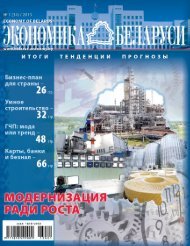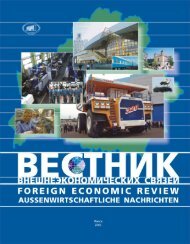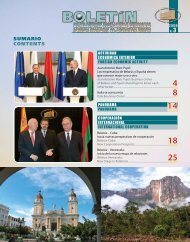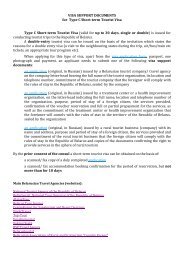Human Development Report 2013 - UNDP
Human Development Report 2013 - UNDP
Human Development Report 2013 - UNDP
You also want an ePaper? Increase the reach of your titles
YUMPU automatically turns print PDFs into web optimized ePapers that Google loves.
<strong>Human</strong> <strong>Development</strong> <strong>Report</strong> <strong>2013</strong>The Rise of the South <strong>Human</strong> Progress in a Diverse WorldPRIMARYENERGY SUPPLY EMISSIONS NATURAL RESOURCES IMPACTSFossilfuelsRenewablesCarbon dioxideGreenhousegasTotal Per capita Per capitaNaturalresourcedepletionForest areaFresh water Endangered Agriculturalwithdrawals species landNumber ofdeaths dueto naturaldisastersPopulationliving ondegradedland(% of total) (megatonnes) (tonnes)(averageannual %growth)(tonnesof carbondioxideequivalent)(% of GNI)(% ofland area) (% change)(% of totalrenewablewaterresources)(% of allspecies)(% of landarea)(annualaverageper millionpeople) (%)HDI rank 2009 2009 2008 2008 1970/2008 2005 2010 2010 1990/2010 2003–2012 a 2011 2009 2005/2011 2010175 Afghanistan .. .. 1 0.0 –4.4 .. 2.6 2.1 0.0 35.6 5.8 58.1 11 11.0176 Guinea-Bissau .. .. 0 0.2 1.4 .. 0.5 71.9 –8.8 0.6 5.7 58.0 1 1.0177 Sierra Leone .. .. 1 0.2 –0.9 .. 2.1 38.1 –12.6 0.3 6.5 47.7 3 ..178 Burundi .. .. 0 0.0 0.6 .. 12.7 6.7 –40.5 2.3 4.5 83.7 2 19.0178 Guinea .. .. 1 0.1 –0.7 .. 14.3 26.6 –9.9 0.7 7.3 58.0 0 1.0180 Central African Republic .. .. 0 0.1 –1.6 .. 0.0 36.3 –2.6 0.0 1.6 8.4 0 ..181 Eritrea 22.6 77.4 0 0.1 .. 0.8 0.0 15.2 –5.5 9.2 7.4 75.2 0 59.0182 Mali .. .. 1 0.0 0.5 .. 9.8 10.2 –11.2 6.5 2.8 33.7 0 60.0183 Burkina Faso .. .. 2 0.1 4.2 .. 4.3 20.6 –17.5 7.9 2.7 43.7 0 73.0184 Chad .. .. 0 0.0 0.8 .. 29.0 9.2 –12.1 0.9 3.7 39.2 2 45.0185 Mozambique 7.7 96.7 2 0.1 –2.9 1.1 3.3 49.6 –10.0 0.3 7.0 62.7 1 2.0186 Congo, Democratic Republic of the 3.7 96.6 3 0.0 –2.8 1.9 13.7 68.0 –3.9 0.0 6.4 9.9 0 ..186 Niger .. .. 1 0.1 0.5 .. 2.4 1.0 –38.1 7.0 3.6 34.6 0 25.0Other countries or territoriesKorea, Democratic People’s Rep. of 81.7 0.7 78 3.2 .. 1.0 .. 47.1 –30.9 11.2 8.6 24.1 5 3.0Marshall Islands .. .. 0 1.9 .. .. .. 70.2 0.0 .. 11.0 72.2 0 ..Monaco .. .. .. .. .. .. .. 0.0 0.0 .. 6.8 .. .. ..Nauru .. .. .. 3.9 .. .. .. 0.0 0.0 .. 12.1 20.0 .. ..San Marino .. .. .. .. .. .. .. 0.0 0.0 .. 0.0 16.7 .. ..Somalia .. .. 1 0.1 0.5 .. .. 10.8 –18.5 22.4 6.8 70.2 2 26.0South Sudan .. .. .. .. .. .. .. .. .. .. .. .. .. ..Tuvalu .. .. .. .. .. .. .. 33.3 0.0 .. 13.0 60.0 .. ..<strong>Human</strong> <strong>Development</strong> Index groupsVery high human development 81.0 7.5 12,643 11.4 –0.2 2.7 0.9 29.1 1.1 8.2 13.6 42.6 8 ..High human development 86.7 9.5 5,765 5.8 1.0 2.8 .. 38.0 –4.1 2.8 11.4 26.5 7 8.4Medium human development .. .. 10,877 3.2 3.8 .. 5.3 24.6 1.3 16.4 12.8 60.9 2 ..Low human development .. .. 473 0.4 0.5 .. 9.5 28.8 –10.6 4.4 7.6 45.8 14 20.2RegionsArab States 96.7 3.1 1,509 4.6 1.1 1.5 .. 7.1 –7.8 87.4 9.4 63.1 1 24.9East Asia and the Pacific .. .. 8,255 4.3 4.5 .. .. 29.4 2.1 .. 12.5 44.9 9 ..Europe and Central Asia 88.3 4.7 3,723 7.9 .. 3.0 7.3 38.5 0.7 5.8 9.6 20.5 13 8.5Latin America and the Caribbean 72.6 26.3 1,637 2.9 1.2 2.7 5.7 47.2 –8.9 1.5 11.5 37.5 3 5.4South Asia 76.7 22.6 2,509 1.5 3.2 0.8 4.0 14.5 2.4 28.6 12.5 33.9 2 10.1Sub-Saharan Africa .. .. 670 0.9 0.4 .. 11.6 28.4 –10.2 1.6 7.5 54.7 1 25.0Least developed countries .. .. 191 0.2 –0.5 .. 9.0 29.6 –9.4 2.8 7.6 47.1 20 26.0Small island developing states .. .. 137 2.7 1.4 .. .. 63.1 –3.5 .. 14.9 3.3 16 ..World 80.7 13.1 29,837 4.5 0.4 1.7 3.3 31.1 –3.3 7.3 11.7 38.6 6 10.6NOTEa Data refer to the most recent year availableduring the period specified.DEFINITIONSFossil fuels: Percentage of total energy supply thatcomes from natural resources formed from biomass inthe geological past (such as coal, oil and natural gas).Renewables: Percentage of total energy supplythat comes from constantly replenished naturalprocesses, including solar, wind, biomass,geothermal, hydropower and ocean resources andsome waste. Nuclear energy is not included.Carbon dioxide emissions: <strong>Human</strong>-originatedcarbon dioxide emissions stemming from the burningof fossil fuels, gas flaring and the production ofcement, including carbon dioxide emitted by forestbiomass through depletion of forest areas.Carbon dioxide emissions per capita: Carbondioxide emissions divided by midyear population.Greenhouse gas emissions per capita:Emissions from methane, nitrous oxide and othergreenhouse gases, including hydrofluorocarbons,per fluorocarbons and sulfur hexafluoride, divided bymidyear population. Carbon dioxide emissions arenot included.Natural resource depletion: Monetary expressionof energy, mineral and forest depletion, expressedas a percentage of total gross national income (GNI).Forest area: Land spanning more than 0.5 hectarewith trees taller than 5 metres and a canopy coverof more than 10%, or trees able to reach thesethresholds in situ. It excludes land predominantlyunder agricultural or urban land use, tree stands inagricultural production systems (for example, in fruitplantations and agroforestry systems) and trees inurban parks and gardens. Areas under reforestationthat have not yet reached but are expected to reacha canopy cover of 10% and a tree height of 5 metersare included, as are temporarily unstocked areas,resulting from human intervention or natural causes,which are expected to regenerate.Fresh water withdrawals: Total fresh waterwithdrawn in a given year, expressed as apercentage of total renewable water resources.Endangered species: Percentage of animalspecies (including mammals, birds, reptiles,amphibians, fish and invertebrates) classified ascritically endangered, endangered or vulnerableby the International Union for the Conservation ofNature.Agricultural land: The sum of areas underarable land (land under temporary agriculturalcrops; multiple-cropped areas are counted onlyonce), temporary meadows for mowing or pasture,land under market and kitchen gardens and landtemporarily fallow (less than five years), expressedas a percentage of total land. Abandoned landresulting from shifting cultivation is excluded.Number of deaths due to natural disasters:Number of people confirmed as dead and missingand presumed dead as a result of a natural disaster.Natural disasters are classified as climatological,hydrological and meteorological disasters, whichinclude drought, extreme temperature, flood, massmovement, wet storm and wildfire.Population living on degraded land: Percentageof the population living on severely or very severelydegraded land. Land degradation estimates considerbiomass, soil health, water quantity and biodiversityand range in severity.MAIN DATA SOURCESColumns 1 and 2: HDRO calculations based on dataon total primary energy supply from IEA (2012).Columns 3 and 4: World Bank (2012a).Columns 5 and 7: HDRO calculations based on datafrom World Bank (2012a).Column 6: HDRO calculations based on data fromWorld Bank (2012a) and UNDESA (2011).Columns 8 and 9: HDRO calculations based on dataon forest and total land area from FAO (2012).Column 10: FAO (2011).Column 11: IUCN (2012).Column 12: HDRO calculations based on data fromFAO (2012).Column 13: CRED EM-DAT (2012) and UNDESA(2011).Column 14: FAO (2012).Table 13 Environment | 193
















